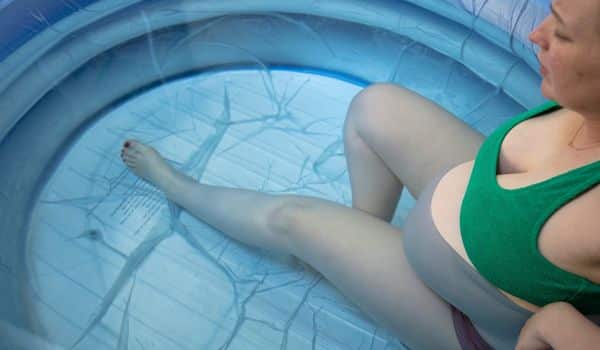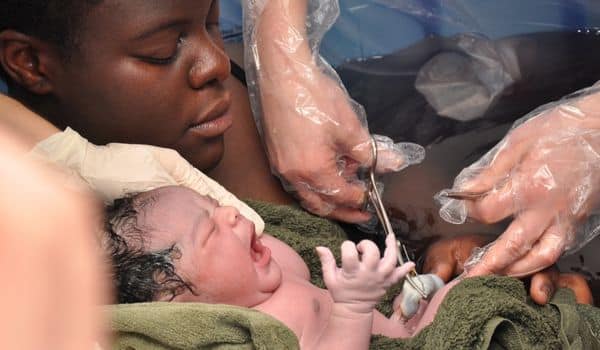Giving birth is one of the most incredible events in life. For parents-to-be who are looking for an unmedicated birth experience, water births may be the perfect option. But what are the benefits of having a water birth? And is it right for you? Let’s look at this unique labor and birth option and learn more about water birthing.
What Is A Water Birth?
As birthing parents are looking for more unmedicated options in their labor and birth journeys, water birth, also known as hydrotherapy or water immersion in a warm bath, is becoming increasingly popular! Water birth is an alternative labor and birth option where the first stage of labor and sometimes even the actual birth of the baby occurs in a pool or tub filled with clean, warm water. Vaginal birth in water can take place at home births, birthing centers, or some hospital birth centers.
Immersion in a water birth tub or pool can be a safe option for birthing parents that can reduce perineal tearing, shorten the length of labor, and help reduce unnecessary interventions.
Numerous studies have found immersion in warm water during labor and birth beneficial for birthing parents. I will review several of these studies in this blog post, and you are welcome to read them yourself. Check out the references section at the bottom of the page to read the scientific journals cited in this post on water birth.

Benefits Of Water Birth
Water birth has several different benefits. For example, being immersed in warm water can help reduce both pain and stress during labor by providing relaxation as well as buoyancy for the birthing parent. In addition to helping with labor pain and making it easier to move around, some women report feeling more relaxed when they are in the tub during delivery because they don’t feel exposed like they would on a hospital bed or on their own bed at home.
Reduced Risk Of Interventions
One of the potential benefits of vaginal birth in a birth pool or birthing tub can also make pain management and moving around to change positions during the first stage of labor easier, which can lead to shorter labor and fewer interventions like epidurals or c-sections. Water birth can possibly reduce the risk of having a cesarean section by 20% (Cunningham, 2016).
Increased Comfort And Pain Management
Laboring parents feel much more comfortable in the birth pool’s warm water, which studies show leads to a reduction in the use of pain medication. The warm water gives pain relief to the laboring woman or birthing person. A study done by Ulfsdottier et al. comparing water births to non-water births found that “The duration of labor was significantly shorter in the water birth group and the frequency of labor dystocia significantly higher in the non-water birth group, as were the interventions amniotomy and use of oxytocin” (Ulfsdottir et al., 2017, p.344-345). Even if you do not plan on giving birth in a birthing pool or birth tub, spending some time during your first stage of labor in a warm bath in your home bathtub or shower can help make contractions more tolerable.
Shorter first and second stage of labor
Risks Associated With Water Births
In any birth experience, there are potential risks, and there can be risks associated with water birth. It’s important to discuss these risks with your midwife or OBGYN before making the decision if water birth is the right choice for you.
When it comes to water birth risks, a potential risk is something called umbilical cord avulsion. Studies at this time are unsure if birthing in a birth pool or birthing tub is the cause of the slight increase in cord avulsion or if it is from providers pulling babies up too fast and harming the umbilical cord because babies are more buoyant in the water compared to land births.
There is also a difference between the experience level of out-of-hospital birthing center midwives and community midwives versus hospital birth center experience. Umbilical cord avulsion may be from less experienced care providers facilitating water birth. More research needs to be done to determine what may be causing the slightly increased risk of umbilical cord avulsion.
If your care provider suspects shoulder dystocia, they may have you step out of the pool and enter a different birth position. Read more about shoulder dystocia.

Water birth requires certain supplies
If you are planning a home birth water birth, your midwife will either bring the birth pool with them when they come to your birth, or they will leave the kit at your home during the third trimester home visit. Some midwives may ask you to buy your own birth pool supplies, which you can order online, or they will bring the supplies with them.
How to prepare for a water birth
Buy all of your water birth tools before you are due.
Water birthing requires a few supplies. If you plan a water birth with a community midwife, like a certified professional midwife, they will most likely provide a list of supplies they will want you to gather before 37 weeks of pregnancy. If you plan for a birth at a hospital or birth center, be sure to check in that they will have all the supplies ready for you when you arrive. A freestanding birthing center may have everything you need for giving birth in the water on hand when you arrive, or it may depend on the midwife utilizing the space.
Have plenty of bath towels available and ready to use.
Water births require a lot of warm towels! If you choose to birth at a birthing center, they will most likely have supplies like warm towels for you to use. If you are planning a home birth, make sure to have at least 8 clean towels ready to go near your birth supplies so the midwives can access them easily when they arrive.
Pick and clear out the space you want to have your birth pool set up.
Tips for planning a water birth.
If you have decided that giving birth in water is the right choice for you, here are some helpful tips for you as you prepare for your birth process and water birth.
Make sure to tell your healthcare provider that you want a water birth.
Educate yourself on what water birth looks like by watching videos on water birth.
Have a conversation with your birthing center, if applicable, to let them know you are planning a water birth.
Your midwifery team may need to add warm water to your birthing pool if you plan a home birth. You can help your birth team by leaving your large stock pots where your birth team can easily access them.
Try not to enter the water before active labor because it could slow down labor.

What To Expect After A Water Birth
After you have given birth to your baby in your birth pool or birth tub, your healthcare provider will monitor your third stage of labor and immediate postpartum while you are in the pool. They do this while you greet your new baby. Water birth babies are typically more relaxed than land birth babies, so you may not experience your baby being born and crying a lot.
Most certified professional midwives are trained to watch for excessive bleeding and postpartum hemorrhage during a water birth. If your care provider becomes concerned about your blood loss, they may utilize intramuscular Pitocin and get you out of the birth pool and onto your bed.
Is Water Birth Right For You And Your Baby?
Making decisions about how you will give birth to your baby is an incredibly personal choice that should not be taken lightly. Before deciding if water birth is right for you and your baby, weigh all the pros and cons carefully. It is important that birthing people and women decide what is best for them and get to make informed choices in their care.
That said, for those having a low-risk pregnancy and looking for an alternative birthing option that provides added comfort throughout labor and delivery while minimizing potential interventions like epidurals and c-sections—water births may be worth considering for you and your baby!

Water birth FAQs
First, let’s start off by understanding that when giving birth, Poop happens, and that’s totally okay! If you happen to pass a bowel movement while giving birth in water, your care provider will use a small fish net to scoop it up and dispose of it. There is a good chance that you will never even notice it ever happened because midwives and labor and delivery nurses are so discrete and quick to clean up for you.
Few hospital labor and delivery units offer water births in their hospital birthing centers. You will need to be very thorough in asking if local hospital labor and delivery units offer water births and if your care provider will facilitate a water birth. If your hospital can facilitate you giving birth in water, you will need to make sure you add that you want to have a water birth in your birth plan. Give a copy of your birth plan to your provider at a prenatal appointment, and make sure to pack a few copies in your hospital birth bag to give to the nurses at labor and delivery when you arrive.
Do not just give them your plan and expect they will read it. Be sure to talk about your birth plan with your nursing team. Nurses working in labor and delivery are very busy caring for patients. You can help your labor and delivery nurses by taking the time to walk through your plan and needs.
If you would like to give birth to your baby at a birthing center, you should ask the birth center manager if they can facilitate water births and if they provide all the necessary supplies. Not freestanding birth centers can provide water birth as an option for customers.
Vaginal birth in a birthing pool requires a specific water temperature. Babies born in water need the water to be at 99 degrees Fahrenheit. This is so the newborn baby does not take its first breath too soon because the water is too cool. Water immersion during the first stage of labor and the second stage of labor increases comfort for the laboring parent because the warm water is soothing to the muscles. Many of your body’s muscles, not just your uterine muscles, work hard during labor!
If the water is too warm, there is an increased risk that the birthing parent’s blood pressure and pulse can be affected. The birth team will carefully monitor the water temperature. If a laboring woman or birthing person shows a change in their vitals, blood pressure, temperature, or pulse change, the birth team will cool the water temperature or ask the parent to get out of the water to cool off.
After your baby is born during a water birth, your birth team will help you keep your baby warm with warm towels. Babies delivered in water births are often more relaxed.
References
Edmonson, M. (2017). Why water birth? Exploring the barriers and challenges for midwives. MIDIRS Midwifery Digest, 27(4), 472–477. Retrieved from https://www.midirs.org/resources/maternity-and-infant-care-mic-database/?gclid=Cj0KCQiA1ZGcBhCoARIsAGQ0kkrXiS6Jl_I2B1McHTDiZmFuM0t33p0ygRVkzqoMspCqt2B4jJnjIvAaAhxCEALw_wcB
Lathrop, A., Bonsack, C. F., Haas, D. M. (2018). Women’s experiences with water birth: A matched groups prospective study. Birth, 45(4), 416–423. https://doi.org/10.1111/birt.12362
Milosevic, S., Channon, S., Hughes, J., Hunter, B., Nolan, M., Milton, R., & Sanders, J. (2019). Factors influencing water immersion during labour: Qualitative case studies of six maternity units in the United Kingdom. BMC Pregnancy and Childbirth, 20(0). https://doi.org/10.1186/s12884-020-03416-7
Neiman, E., Austin, E., Tan, A., Anderson, C., & Chipps, E. (2020). Outcomes of waterbirth in a US hospital-based midwifery practice: A retrospective cohort study of water immersion during labor and birth. Journal of Midwifery and Women’s Health, 65(2), 216-223. https://doi.org/10.1111/jmwh.13033.
Ulfsdottir, H., Saltvedt, S., & Georgsson, S. (2017). Water Birth in Sweden – A comparative study. Acta Obstetricia et Gynecologica Scandinavica, 97(3), 341-348. https://doi.org/10.1111/aogs.13286





